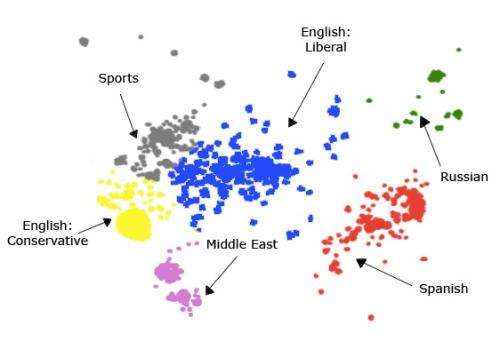Network of Twitter users who tweet BBC online articles. User nodes are colored according to the topic or language of articles they share the most. Network edges have been omitted for clarity.
Where do people get their news, and how does information spread through social networks? Researchers at the New England Complex Systems Institute (NECSI) analyzed how BBC articles are shared through Twitter, and discovered how the BBC successfully reaches multiple audiences. Mapping social networks, especially around the dissemination of news, makes it possible to forecast—with a growing degree of accuracy—social and political movements, technology adoption, and economic behavior.
The report, "An Exploration of Social Identity: The Structure of the BBC News-Sharing Community on Twitter," by Julius Adebayo, Tiziana Musso, Kawandeep Virdee, Casey Friedman, and Yaneer Bar-Yam, looked at almost 500,000 tweets sharing BBC links over the course of six days, and created a map of the network of who is following whom.
The BBC is unique in that it provides local news in multiple languages around the world. This is apparent in the study, as there are substantial separate audiences for Russian, Spanish, Arabic, and English coverage, with connections within each language group but very few connections between them. The authors attribute this linguistically and geographically widespread influence to the BBC's historical role as the provider of trustworthy news in countries with histories of press restrictions, including Chile, Egypt, Mexico, Pakistan, Russia, and Venezuela.
Twitter users who share BBC articles in English can further be divided into four subgroups. One is primarily focused on sports; two other clusters are mostly interested in UK news—one apparently associated with the Conservative party (with the frequent keywords being "business," "marketing," and "financial") and one with the Labour party ("politics," "student," "science," and "labour"), reflecting the political polarization of the British electorate. The fourth group is primarily focused on the Middle East. While the first three are mostly composed of users from the UK, the last group is closely linked to many Arabic speakers from the Middle East. Unlike previous research conducted by the same authors using stories from The New York Times, the analysis did not show any overarching cosmopolitan group.
"We know that social media is playing a role in revolutionary events in the world and therefore knowing how people interact with each other can help us understand or even anticipate social events" said Bar-Yam. "Science is giving us the opportunity to map these global social interactions."
More information: Adebayo, J. et al. An Exploration of Social Identity: The Structure of the BBC News-Sharing Community on Twitter. NECSI Report 2013-08-02 (08/20/2013). www.necsi.edu/research/social/ … itter/bbctwitter.pdf
Provided by New England Complex Systems Institute




















